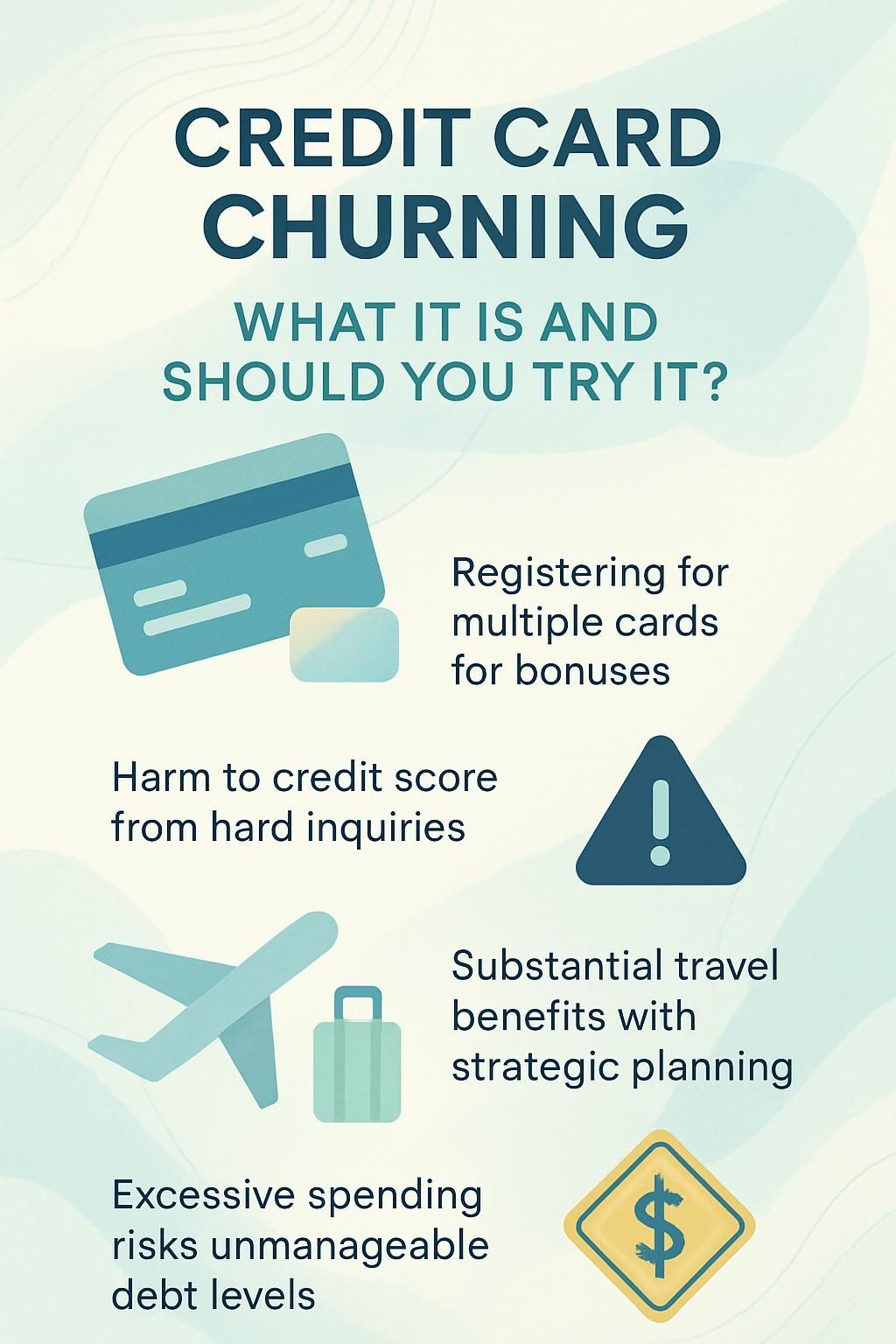Credit Card Churning: What It Is and Should You Try It?
You may wonder if credit card churning is a smart way to boost your rewards and cash back. This strategy means applying for new credit cards to get big sign-up bonuses or travel perks like airline miles.
In this article, you will learn how churning works, what the risks are, and whether it makes sense for someone with strong finances and good credit scores. Curious if chasing those reward points is right for you? Keep reading.
Key Takeaways
- Credit card churning involves registering for multiple credit cards to earn sign-up bonuses and rewards, but it demands a high level of financial discipline and organizational skills to avoid potential hazards like harming your credit score or piling up debt.
- Handling several accounts requires paying attention to spending needs, application dates, and payment deadlines. Neglecting these can result in losing bonuses, dealing with late charges, or decreasing your FICO score.
- The perks of successful churning include acquiring substantial travel benefits like airline miles and free airport lounge access. But, one must plan card applications and closures strategically to balance costs and make the most of rewards.
- Launching multiple accounts can lead to hard inquiries on your report, which can bring down your credit score for a short period. Also, spending excessively just to meet minimum spend conditions could drive up unmanageable debt levels.
- Gaining rewards without resorting to churning can be achieved by selecting a rewards card that aligns with personal consumption patterns, paying off balances each month, and using cards with 0% starting APR offers for purchases or balance transfers.

What is credit card churning?

Credit card churning is the strategy of applying for several credit cards to earn sign-up bonuses, then canceling or downgrading each account before annual fees kick in. Skilled churners often target banks like Chase, Capital One, and American Express because their rewards programs offer large welcome bonus points, cash back, or airline miles after meeting minimum spending requirements.
Financial advisers warn that this method is legal but risky since missing payments or overspending can lower your FICO score and affect future loan applications for things like a home loan.
People with strong financial discipline manage multiple credit card accounts at once, keeping close track of deadlines and spending thresholds to collect perks such as complimentary airport lounge access.
Many travel hackers use this technique to rapidly build up loyalty program balances by hitting minimum spend targets on new cards. “The goal for most experienced churners is simple,” said one investment adviser: “maximize reward points while minimizing costs.” Next, see how the actual process works and what plays into earning those big sign-up bonuses.
How credit card churning works
Credit card churning uses new credit card applications to collect sign-up bonuses and rewards points. People often open multiple credit accounts from major issuers like Chase or Amex, tracking spending goals and bonus offers to get perks like airline miles or cash back.
How do you apply for cards to earn sign-up bonuses?
Applying for credit cards to earn sign-up bonuses requires a careful plan. Your goal is to gain as many rewards as possible while safeguarding your credit score. Here’s how you can effectively implement these tactics:
- Investigate the available credit card offerings carefully, centering your attention on those with attractive welcome bonuses, such as airline miles or cash back. Platforms like Mastercard International or American Express provide a broad range of choices.
- Grasp the spending requirements to access these bonuses. Most cards necessitate you to expend a certain sum within the initial few months.
- Utilize your financial advantage to fulfill minimum spending requirements without exceeding your budget. Think about paying for planned large purchases or monthly expenses.
- Keep track of the application timeline. Distribute your applications to dodge too many hard inquiries on your credit report simultaneously.
- Oversee new accounts responsibly by scheduling automatic payments to cover at the very least the minimum due each month, evading late fees and interest expenses.
- Check your credit score frequently through services offered by credit bureaus or free online instruments. This routine aids in evaluating the influence of your applications and new accounts.
- Strategize the shut down or downgrade of cards intelligently to circumvent annual fees without impacting your credit utilization ratio substantially.
- Make use of loyalty programs by choosing cards that boost reward points for categories where you expend the most, like travel or dining.
I have personally executed these steps during my experience, commencing with one card and growing cautiously from there. Through regular tracking and mindful management, I accessed several sign-up bonuses that funded numerous international adventures without accumulating debt or affecting my credit score excessively.
What are spending requirements to unlock rewards?
Credit card issuers set minimum spending requirements for new rewards cards. To unlock the welcome bonus, you may need to spend $3,000 or more with your credit card in the first 90 days after approval.
This threshold lets you collect valuable cash back, airline miles, or reward points. Every issuer sets different terms; for example, Citi might require a $4,000 spend in three months while Chase could ask for $5,000.
Some cards only count net purchases toward this goal—big-ticket items like luxury travel or fine dining often make it easy to meet these targets quickly if you have high monthly expenses.
Missing even one dollar means forfeiting hundreds of dollars’ worth of sign-up bonuses and perks such as complimentary airport lounge access or statement credits. “To get those juicy rewards,” says financial advisor Laura Adams, “you must hit every part of the requirement within the deadline.” Understanding why people close accounts after earning their bonuses sheds light on common churner strategies.
Why do people cancel or abandon cards after bonuses?
Many people cancel or downgrade credit cards after they receive the welcome bonus to avoid paying annual fees. Once they earn sign-up bonuses and redeem rewards like airline miles, cash back, or reward points, some cardholders stop using those accounts.
Managing fewer cards makes tracking spending requirements easier and helps prevent missing monthly payments. Churners often abandon a card if it lacks valuable perks such as complimentary airport lounge access or strong travel rewards compared to other options.
Dropping unused accounts also minimizes risk of overspending and simplifies their credit utilization ratio. People focused on optimizing credit card rewards do not want extra lines open that add no real benefit once the initial reward is secured.
Many choose to close these cards before the next annual fee renewal date hits, which aligns with common churning strategies seen with popular issuers like American Express and Chase under rules such as 5/24.
Benefits of credit card churning
Credit card churning can help you rack up airline miles, cash back, and reward points fast through welcome bonuses and rewards programs—read on to see how these perks stack up.
How can you accumulate travel rewards and cash back?
Churning cards offers a strategic way to collect large amounts of travel rewards and cash back. Apply for several new credit card accounts to secure sign-up bonuses, like 60,000 airline miles or $500 in cash after meeting minimum spending requirements.
Spend on each card until you hit the target—usually between $3,000 and $5,000 within three months—to release these welcome bonuses.
These perks can pile up quickly if you manage your cards well and track spending closely. Many travel hackers organize their applications around loyalty programs from major airlines or hotel groups such as American Airlines AAdvantage or Marriott Bonvoy.
Careful management helps avoid late payments that impact your credit score while squeezing every benefit from annual fee offers and complimentary airport lounge access. Analyzing which cards fit specific purchases adds even more value; sometimes one earns extra points for dining while another pays higher rates on travel bookings.
Next up: discover the best sign-up bonuses to unlock with this approach.
What are the best sign-up bonuses to unlock?
Stacking credit card rewards starts with smart sign-up bonus choices. Top travel cards often offer massive points and miles for meeting minimum spending requirements within the first few months.
For example, some premium chase cards grant 60,000 or more reward points when you spend $4,000 in three months. “Earn big on travel by unlocking high-value welcome bonuses,” says many seasoned travel hackers.
Luxury cards can bring perks like complimentary airport lounge access or annual travel credits with your rewards boost. Cash back lovers may target cards with $200 to $300 cash offers after meeting simple qualifying spends, which instantly benefits your bottom line.
To maximize value, check each card’s annual fees and points redemption rates before sending new credit card applications to issuers.
Risks of credit card churning
Churning credit cards for sign-up bonuses can hurt your credit score and lead to missed payments if you lose track of monthly bills or open too many accounts, so keep reading to learn how these risks stack up.
How can credit card churning affect your credit score?
Opening several credit card accounts in a short time can cause your credit score to drop. Hard inquiries from many credit card applications stack up on your credit reports, and each may lower your score by about five points.
If you miss monthly payments or forget due dates while juggling rewards programs, expect even greater damage to your FICO score. I’ve seen wealthy clients caught off guard after canceling cards for which they earned big welcome bonuses; suddenly their average account age drops and their total credit limit shrinks, driving up their credit utilization ratio.
Using large amounts of available credit just to hit minimum spending requirements can also set off red flags with lenders. Financial discipline becomes vital if you want to maximize rewards without hurting your profile with Equifax or Experian.
Managing multiple accounts increases the risk of overspending and growing debt—two sure ways to hurt a once-strong personal finance standing fast. Managing these risks leads directly into understanding how churning affects both your spending patterns and your financial health next.
What are the risks of overspending and debt?
Trying to hit minimum spending requirements for sign-up bonuses can push people to spend more than they planned. Meeting these targets often leads cardholders to make large or extra purchases, sometimes on things they do not need.
This kind of behavior raises the risk of accumulating debt, especially if balances are not paid in full each month. High balances increase credit utilization ratios, which can lower your credit score and hurt approval odds for future credit card applications.
Managing multiple rewards cards also creates administrative headaches and increases the chance of missing a payment deadline. Even one late payment may drop a strong credit score by over 100 points according to FICO data from 2023.
Rich individuals chasing top-tier rewards, like complimentary airport lounge access or airline miles, still face high annual percentage rates if debts go unpaid. Banks profit when you slip up; interest charges on overspent amounts quickly wipe out any travel rewards or cash back earned through churning strategies.
“Overspending just to chase rewards is a fast way to lose wealth faster than any welcome bonus can recover.”
How credit card churning can impact your credit
Credit card churning can change your credit score by affecting factors like your credit utilization ratio, the age of your accounts, and how many hard pulls appear on your report—read ahead to see how these changes could shape your finances.
How does churning affect credit utilization and history?
Opening multiple credit card accounts in a short period causes hard inquiries from card issuers, which can drop your credit score. Each new application briefly lowers your average account age and increases the number of recent inquiries on your record.
Managing several cards to earn sign-up bonuses also impacts your credit utilization ratio if you overspend or close old cards, since fewer open accounts mean each balance weighs more heavily against your total available credit.
Missing payments while juggling many rewards programs damages payment history, the biggest factor in your score. My own experience with pursuing high-value welcome bonuses showed me how easy it is for one late monthly payment to erase years of positive progress.
Rich individuals with large lines of credit still face risk; a single missed bill on even one platinum card can leave a costly mark for up to seven years on their report. Experts warn that without strict financial discipline, churning quickly becomes a liability rather than an asset for building creditworthiness or long-term perks like complimentary airport lounge access.
What challenges come with managing multiple accounts?
Managing multiple credit card accounts creates real headaches, even for the most organized people. Keeping up with payment deadlines on several cards demands strict attention; a single missed due date can lead to late fees and fast drops in your credit score.
I once tracked six different minimum spending requirements at the same time, and nearly overlooked an annual fee that would have cost me hundreds if not cancelled in time.
Juggling rewards points, airline miles, cash back offers, and monthly statements across many issuers means frequent logins and more room for error. Opening too many accounts too quickly can reduce your credit utilization ratio while also leading to hard inquiries that impact your credit history.
Strong discipline is necessary because chasing every sign-up bonus can tempt anyone into overspending just to meet those high thresholds set by card issuers. Systems like spreadsheets or personal finance apps help, but mistakes happen fast without solid organization skills.
Tips for maximizing rewards without churning
Maximize your credit card rewards by choosing a card that matches your spending habits and reward goals—read on to see how the right strategy can help you earn more points without juggling dozens of accounts.
How to choose the right rewards card for your spending?
Selecting an appropriate rewards card that best suits your spending habits necessitates a rational approach. It requires an analysis of various proposals from credit card issuers to identify one that coincides with your fiscal objectives and way of life.
- Review your expenditure trends. Identify where your major expenses occur each month. This might be dining, traveling, groceries, or fuel. Opt for a credit card that gives the best reward rates for these categories.
- Look at the introductory bonuses on offer. Cards frequently propose a generous welcome bonus for new account owners who meet preliminary spending prerequisites. Opt for a card whose bonus you can easily attain without modifying your usual expenditure routines.
- Compare annual fees with benefits. Some high-end cards charge substantial annual fees but provide perks like free access to airport lounges, complimentary hotel stays, or travel insurance that can outweigh the cost if leveraged efficiently.
- Scrutinize the reward redemption alternatives. Ascertain that the card allows you to exchange points in a way that fits you best, whether it’s cash back, travel rewards, or transferring points to airline and hotel loyalty programs.
- If travel benefits are a priority for you, take into account the credit issuer’s affiliations with airlines and hotels. Cards that offer exchangeable points might provide more worth through partner redemptions than those restricted to single-brand usage.
- Familiarize yourself with the conditions concerning reward expiry and caps on earnings as some cards may put a limit on the cashback or the number of points you can earn within a specified period.
- Look at extra benefits like insurance coverage, be it travel cancellation insurance or extended warranty protection on purchases which provide added value beyond just earning points or cash back.
- Study the card’s interest rates for purchases and balance transfers if you occasionally keep a balance; even though settling your monthly bill in full is always the best strategy to sidestep interest charges completely.
- Explore downgrade options with the same issuer to evade annual fees in subsequent years without closing accounts which could negatively affect your credit utilization ratio.
- Keep yourself updated about specific restrictions like the Chase’s 5/24 rule which could restrict your ability to establish new accounts if you have already requested too many credit cards within a limited time span.
By methodically examining these criteria with your present needs and potential future requirements in mind, you guarantee that your selected credit card functions as an efficient instrument for improving your personal financial plan, all while reaping valuable rewards and perks suitable for your lifestyle and spending patterns.
What long-term financial strategies help maximize rewards?
Choosing the right rewards card establishes a foundation for increasing benefits. Building long-term financial strategies further strengthens that base, promoting your reward gathering over time.
- Pay off balances each month to elude interest charges. This strategy maintains the worth of cash back and points accrued.
- Deploy cards smartly for routine spending to fulfill minimum spending conditions without exceeding budget.
- Expand your collection of cards to encompass different categories such as travel, groceries, and gas where reward rates are more promising.
- Keep track of credit card issuers’ specials and exploit time-bound offers that can escalate your points pool.
- Associate cards with loyalty programs from airlines or hotels to amplify rewards on every dollar expended.
- Organize a yearly appraisal of your credit cards to evaluate perks contra annual fees and decide if some need replacement.
- Opt to downgrade instead of canceling cards to conserve credit history while cutting down annual fees, evading a detrimental effect on your credit score.
- Be mindful of the Chase 5/24 regulation which restricts approvals for new cards if you’ve initiated five or more in the preceding 24 months.
- Use shopping portals provided by issuers to acquire additional points or miles on digital purchases.
- Bargain for improved conditions or bonus offers with issuers prior to mulling over closing an account; they might present enticements to keep you as a customer.
Adhering to these strategies enhances the rewards you garner and also shields against usual traps like debt pile up and adverse impacts on your credit score, assuring a financially sound future while reaping superior benefits from your credit cards.
How can you avoid paying credit card interest legally?
Maximizing rewards from credit cards demands a smart strategy to bypass interest charges. Here’s how you can use your cards without incurring extra costs:
- Pay your balance in full every month. This simple practice ensures you never pay interest on purchases.
- Set up auto-pay to avoid late payments. Automatic payments can help maintain a good payment history and prevent interest from accumulating due to missed deadlines.
- Use a grace period to your advantage. Most credit card issuers offer a grace period between the end of your billing cycle and the payment due date, allowing you time to pay off the balance without accruing interest.
- Apply for cards with a 0% introductory APR offer for purchases. These offers mean you won’t pay interest on purchases for a set time, typically 12-18 months, but it’s crucial to pay the balance before this period ends.
- Consider transferring high-interest balances to a card with a 0% introductory APR on balance transfers. This move can provide relief from interest charges while you work on paying down debt, though watch out for any transfer fees.
- Avoid cash advances when possible. Cash advances usually come with higher APRs and no grace period, leading to immediate interest charges.
- Make strategic big purchases right after your billing cycle starts. This gives you the maximum time possible before your next payment is due, extending the period your money works for you without interest.
- Monitor sign-up bonuses carefully and aim for cards that align with your spending habits and financial goals instead of just chasing high rewards.
From personal experience, employing these tactics efficiently has allowed me to enjoy significant travel perks and cash back without paying extra in interest fees or falling into debt traps common among less cautious credit card users.
Conclusion
Credit card churning can help you rack up travel points or cash back fast, but it demands strict attention to detail and risk management. Applying for many credit cards at once may impact your credit score and create headaches with monthly payments.
If you have strong organizational skills and never miss a payment, you could benefit from sign-up bonuses and reward programs like airline miles or complimentary airport lounge access.
Someone who prefers simplicity should stick to just one or two rewards cards that fit daily spending habits instead of juggling multiple accounts. Weigh each move carefully before starting any new credit card application strategy.
For more detailed strategies on minimizing costs, check out our guide on how to avoid paying credit card interest legally.
FAQs
1. What is credit card churning?
Credit card churning refers to the practice of repeatedly opening and closing credit cards to earn sign-up bonuses, rewards points, or other perks offered by the credit card issuers.
2. How does credit card churning affect my credit score?
Applying for numerous credit cards can lead to hard inquiries on your report which may negatively impact your score. Also, missed payments or high utilization ratios due to multiple monthly payments can further decrease your score.
3. Should I consider trying out this method for earning travel rewards and cash back?
While it’s possible to earn significant travel rewards and cash back through churning, it requires careful management of spending requirements and annual fees. It also involves a potential risk to your personal finance if not handled properly.
4. Can anyone apply for multiple cards in order to churn them?
Mostly yes, but some rules like Chase 5/24 rule limit the number of new accounts you can open within a certain timeframe. Also, late payments or low scores might influence issuer’s decision on granting you another line of credit.
5. Are there any additional benefits apart from reward points that come with these cards?
Yes! Some cards offer complimentary airport lounge access, loyalty programs as well as other special benefits that enhance the value proposition beyond just earning reward points.
6. Is there any financial advice related to managing several active accounts while engaging in this activity?
It’s crucial not only meeting minimum spending requirements without overspending but also keeping track on all due dates so no monthly payment is missed; moreover downgrading expensive annual fee cards could be considered when bonus period ends.

 Previous Post
Previous Post Next Post
Next Post